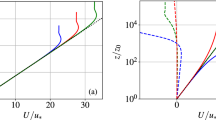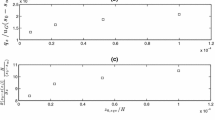Abstract
Experimental evidence indicates that there is a significant departure of the wind profile above the underlying surface consisting of patches of solid and liquid parts, and plant communities with different morphological from that predicted by the logarithmic relationship, which gives the values larger than those observed. This situation can seriously affect the transfer of momentum, heat and water vapor from the surface fluxes into the atmosphere.
The object of this paper is to generalize the calculation of the exchange of momentum between the atmosphere and a very heterogeneous surface, find a general equation for the wind speed profile in a roughness sublayer under neutral conditions, and, then, derive aggregated roughness length and displacement height over the grid cell. The suggested expression for the wind profile is compared with some earlier approaches, using a common parameterization of aerodynamic parameters over the grid cell, and the observations obtained at an experimental site in Philadelphia, PA.
Similar content being viewed by others
References
Burke, E.J., Shuttleworth, W.J., Yang, Z.-L. and Arain, M.A.: 2000, The impact of the parameterization of heterogeneous vegetation on the modeled large-scale circulation in CCM3-BATS, Geophys. Res. Lett. 27, 397–400.
Hess, G.D. and McAvaney, B.J.: 1997, Note on computing screen temperatures humidities and anemometer-height winds in large-scale models, Aust. Meteorol. Mag. 46, 109–115.
Hess, G.D. and McAvaney, B.J.: 1998, Realisability constraints for land-surface schemes, Global Planet. Change 19, 241–245.
Claussen, M.: 1991, Estimation of areally-averaged surface fluxes, Boundary-Layer Meteorol. 30, 327–341.
Claussen, M.: 1995, Flux aggregation at large scales: On the limits of validity of blending height, J. Hydrol. 166, 371–382.
Delage, Y., Wen, L. and Belanger, J.-M.: 1999, Aggregation of parameters for the land surface model CLASS, Atmos.-Ocean 37, 157–178.
Mason, P.J.: 1988, The formulation of areally averaged roughness lengths, Quart. J. Roy. Meteorol. Soc. 114, 399–420.
Bottema, M.: 1995, Parameterization of aerodynamic roughness parameters in relation to air pollutant removal efficiency of streets. In: H. Power et al. (eds.), Air Pollution Engineering and Management, pp. 235–342, Computational Mechanics.
Grimmond, C.S.B., King, T.S., Roth, M. and Oke, T.R.: 1998, Surface aerodynamic characteristics of urban areas: anemometric analysis, Boundary-Layer Meteor. 89, 1–24.
Kondo, J. and Yamazawa, H.: 1986, Aerodynamic roughness over an inhomogeneous ground surface, Boundary-Layer Meteorol. 35, 331–348.
Nicholas, F.W. and Lewis Jr., J.E.: 1980, Relationship between aerodynamic roughness and land use and land cover in Baltimore, Maryland, 36 pp., Geological Survey, Prof. Paper, 1909-C, U.S. Govt. Printing Office, Washington, D.C. (Available from U.S. Government Printing Office, Washington DC 20402.)
Raupach, M.R.: 1994, Simplified expressions for vegetation roughness length and zero-plane displacement as functions of canopy height and area index, Boundary-Layer Meteorol. 71, 211–216.
Dickinson, R.E., Henderson-Sellers, A., Kennedy, P.J. and Giorgi, F., 1992, Biosphere-Atmosphere Transfer Scheme (BATS). Version 1e as a coupled to the NCAR Community Climate Model, NCAR Tech. Note.
Rotach, M.W.: 1998, Determination of zero plane displacement in an urban area, Boundary-Layer Meteorol. 67, 187–193.
Wimega, J.: 1992, Representative roughness parameters for homogenous terrain. Boundary-Layer Meteorol. 63, 323–363.
Fernando, H.J.S, Lee, S.M, Anderson, J., Princevac, M., Paradyjak, E. and Grossman-Clarke, S.: 2001, Urban fluid mechanic: Air circulation and contaminant dispersion in cities, Environ. Fluid Mech. 1, 107–164.
Grimmond, C.S.B. and Oke, T.R.: 1997, Aerodynamic properties of urban areas derived from analysis surface form, J. Appl. Meteor. 38, 1262–1292.
Roth, M.: 2000, Review of atmospheric turbulence over cities, Quart. J. Roy. Meteorol. Soc. 126, 941–990.
Mihailovic, D.T., Lalic, B., Rajkovic, B. and Arsenic, I.: 1999, A roughness sublayer wind profile above non-uniform surface, Boundary-Layer Meteorol. 93, 425–451.
Lalic, B.: 1997, Profile of wind speed in transition layer above the vegetation. Masters Thesis, University of Belgrade, 72 pp. (in Serbian). (Available from Institute of Meteorology, Faculty of Physics, Dobracina 16, 11000, Belgrade, Yugoslavia.)
Lalic, B. and Mihailovic, D.T.: 1998, Derivation of aerodynamic characteristics using a new wind profile in the transition layer above the vegetation, Res. Activ. Atmos. Oceanic Modell. Rept. 27, 4.25–4.26.
Morgan, D.L., Pruitt, W.O. and Lourence, F.J.: 1971, Analysis of energy, momentum, and mass transfers above vegetative surfaces, 127 pp, Research and Development Technical Report ECOM 68-G10-F, Department of Water Science and Engineering, University of California, Davis, U.S.A.
Jacobs, A.F.J., and van Boxel, J.H.: 1988, Changes of the displacement height and roughness length of maize during a growing season, Agric. For. Meteorol. 42, 53–62.
De Bruin, H.A.R. and Moore, C.J.: 1985, Zero-plane displacement and roughness length for tall vegetation, derived from a simple mass conservation hypothesis, Boundary-Layer Meteorol. 42, 53–62.
Delage, Y. and Verseghy, D.: 1995, Testing the effects of a new land surface scheme and of initial soil moisture conditions in the Canadian – global forecast model, Mont. Weat. Rev. 123, 3305–3317.
Mihailovic, D.T. and Kallos, G.: 1997, A sensitivity study of a coupled soil-vegetation boundary-layer scheme for use in atmospheric modeling, Boundary-Layer Meteorol. 82, 283–315.
Mihailovic, D.T., Lalic, B., Rajkovic, B. and Arsenic, I.: 2001, The land surface parameterization scheme (LAPS): Further development of the turbulence in and above plant canopies, compilation of the biophysical input parameters and calculating the temperature over solid surface, Boundary-Layer Meteorol. (submitted).
EPA: 1990, User's guide for the Urban Airshed Model-Volume 1; user's manual for UAM(CBIV). U.S. Environmental Protection Agency, Research Triangle Park, N.C., EPA-450/4–90–007a.
Kondo, J.: 1975, Air-sea bulk transfer coefficient in diabatic conditions, Boundary-Layer Meteorol. 9, 91–112.
Philbric, C.R.: 1998, Investigations of factors determining the occurrence of ozone and fine particles in northeastern USA. In: Measurements of Toxic and Related Air Pollutants, pp. 248–260, Air & Waste Management Association and the U.S. EPA's National Exposure Research Laboratory, Cary, NC.
van Pul, W.A.J.: 1992, The flux ozone to a maize crop and underlying soil during a growing season, Ph.D. Thesis, Wageningen Agricultural University, 147 pp.
Author information
Authors and Affiliations
Rights and permissions
About this article
Cite this article
Mihailovic, D.T., Rao, S.T., Hogrefe, C. et al. An Approach for the Aggregation of Aerodynamic Surface Parameters in Calculating the Turbulent Fluxes over Heterogeneous Surfaces in Atmospheric Models. Environmental Fluid Mechanics 2, 315–337 (2002). https://doi.org/10.1023/A:1020487528913
Issue Date:
DOI: https://doi.org/10.1023/A:1020487528913




